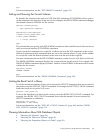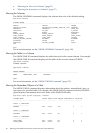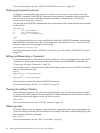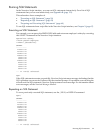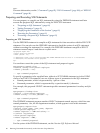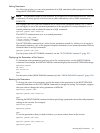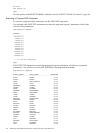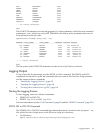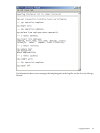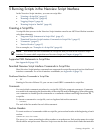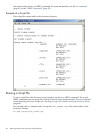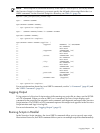TED MCDONALD 2000
PETER SMITH 3300
MARK FOLEY 4000
HEIDI WEIGL 3200
ROCKY LEWIS 2000
SUE CRAMER 1000
MARTIN SCHAEFFER 3200
HERBERT KARAJAN 3200
JESSICA CRINER 3500
--- 35 row(s) selected.
SQL>
This EXECUTE statement executes the prepared findemp statement, which has two unnamed
parameters: ?sal, which was set by SET PARAM for the salary, and a parameter that was not
set in advance for the job code:
SQL>execute findemp using ?sal, 100;
EMPNUM FIRST_NAME LAST_NAME DEPTNUM JOBCODE SALARY
------ --------------- -------------- ------- ------- --------
213 ROBERT WHITE 1500 100 90000.00
23 JERRY HOWARD 1000 100 137000.10
1 ROGER GREEN 9000 100 175500.00
29 JANE RAYMOND 3000 100 136000.00
32 THOMAS RUDLOFF 2000 100 138000.40
43 PAUL WINTER 3100 100 90000.00
65 RACHEL MCKAY 4000 100 118000.00
--- 7 row(s) selected.
SQL>
For the syntax of the EXECUTE statement, see the Neoview SQL Reference Manual.
Logging Output
To log a Neoview Script session, use the SPOOL or LOG command. The SPOOL and LOG
commands record into a log file the commands that you enter in the Neoview Script interface
and the output of those commands.
• “Starting the Logging Process” (page 63)
• “Stopping the Logging Process” (page 64)
• “Viewing the Contents of a Log File” (page 64)
Starting the Logging Process
To start logging, enter one of these commands:
• SPOOL ON or LOG ON
• SPOOL log-file or LOG log-file
For more information, see the “LOG Command” (page 91) and the “SPOOL Command” (page 130).
SPOOL ON or LOG ON Command
The SPOOL ON or LOG ON command logs information about a session in the sqlspool.lst
file, which Neoview Script stores in the Neoview Script bin directory:
• On Windows:
hpnvs-installation-directory\nvscript\bin\sqlspool.lst
Logging Output 63



